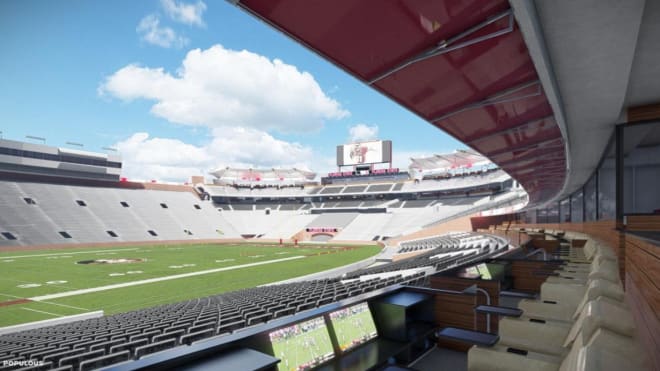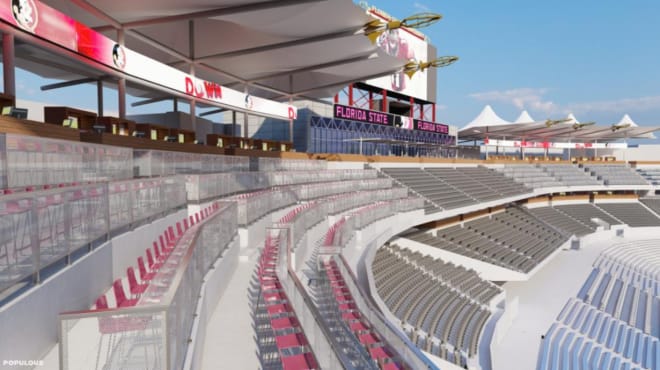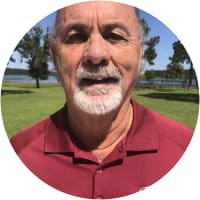Doak renovation project clears latest hurdle with BOT approval

On Friday, October 27, the Florida State Board of Trustees approved the Doak Campbell Stadium Improvement Project, which has been under formal study by Florida State and its governing agencies since 2021.
Board of Trustees Chairman Peter Collins, who had postponed the vote at the October 8 Board of Trustees meeting in order to give trustees additional time to study the massive project, turned the meeting over to Florida State Vice President and Chief Financial Officer Kyle Clark, Vice President and Athletic Director Michael Alford and Seminole Booster President and CEO Stephen Ponder who would make the presentation, which was recommended for presentation by the BOT Finance and Business Committee and by the Florida State University Athletic Association.
The project has been presented 28 times to governing bodies since inception in 2021, with three approvals remaining, one by the Board of Governors on November 8-9, another by the Governor’s Cabinet on November 10-11 and finally by the Governor.
The improvement project, which will enhance Doak Campbell Stadium and build the Dunlap Football Complex, will have a major impact on the Florida State campus over the next 18 months and on all FSU season ticket holders.
The high-maintenance, west sideline metal structure, built in 1950, will be replaced by a concrete structure featuring wider seats with more leg room, spacious, well-lit concourses, enhanced concessions, restrooms and gathering spaces for all season ticket holders. In addition, FSU will build premium club seating in the lower rows, mid-level Founders Suites, Founders Loge Boxes and a private club. Above the mid-level, FSU will build chair-back seats as well as wider bleacher seats, with expanded leg room, and access to the same new concourses, concessions and restrooms as the chair-back seat buyers.
The project will diversify the seating option in the Dunlap Champions Club, located in the south end zone as well as widen seats and aisles on the east sideline in order to add handrails.
While the north end zone will be unaffected, construction will run concurrently with the Dunlap Football Building which will be built in the parking lot next to the football practice fields just outside the north end zone.
The project will begin immediately after the North Alabama game at the end of the 2023 season and be completed for FSU’s 2025 home opener against Alabama.

Osceola publisher Jerry Kutz answers reader questions about the project
After Alford and Ponder presented the facility renderings and features along with a sales report, VP Clark presented a sources and uses of funds to bond finance the $250-million-plus project as well as a construction timeline.
Prior to taking the vote, Chairman Collins opened the meeting to discussion.
“This will be one of the bigger capital expenditures, or debt issuances, we will approve. It’s important, and I appreciate everybody leaning in and taking the time,” Collins began. “I know most of you got your questions answered in your one-on-one (meetings), but if anybody has any questions, or things you’d like to discuss about this, now is the time. I’ll wait for a motion, and we’ll just have some general discussion about it if anyone wants to comment.”
Trustee Kathryn Ballard, a longtime Seminole fan, asked the first of three questions every season ticket holder has been asking since the project became public. Ballard is the daughter of former Board of Trustees Chairman Jim Smith.
“Are we losing any seats at the end of the day and if so how many?” the 1987 graduate of the College of Human Sciences asked.
Alford answered the question.
“As we go through this project, we will be minimizing some seats in the south end zone (Dunlap Champions Club) because we have 5,900 seats there. We don’t know how many we will have until we actually install them, but we will go down in the south end zone to about 3,500,” Alford said. “As Stephen (Ponder) pointed out before, the club spaces were only ever built to hold that many seats when we originally did the project and we’ve only ever been sold about 51 percent of that experience as it stands, so we will get it down to something more manageable but with different experiences will actually produce a higher yield. It will also allow us to cover the bond debt from years ago (2016).”
Alford explained there would be a seat loss by increasing the tread depth on the west side and widening aisles to accomodate handrails throughout the stadium.
“There will be a slight reduction in seating throughout the stadium,” he noted. “We will be monitoring that and working closely with our architects to make sure we capitalize on maximizing as many seats as possible. If you go through attendance throughout the years, we will be hitting the mark of where we should be. We imagine right now, working with the architects, we will be somewhere around the 70,000-seat mark.”
Chairman Collins summarized Alford’s remarks. “As I understand it, it is probably an overall loss of around 9,000 seats, Trustee Ballard. Is that right AD Alford?” Collins asked.
“Estimation. Yes, sir,” Alford responded.
“Until we actually build it and start putting numbers on things, and see, we won’t know for sure but that’s a rough number,” Collins concluded.
Ballard asked her follow-up question, a question every Seminole fan is asking.
“Say someone has had season tickets for 20 years. What’s going to happen to that person?” Trustee Ballard responded.
“That’s a good question,” Collins responded. “Everybody that has a season ticket on the west side or in the Champions Club, we’re not getting rid of seats below the number of season ticket holders we have, so everybody is going to have an opportunity to still have a seat, whether they choose to pay for that seat or move locations is going to be up to them but we are not losing more seats than we have season ticket holders.”
“Are they going to be significantly more expensive for the season ticket holder?” Ballard asked.
Ponder fielded her question.
“Trustee Ballard, the reason we are going person by person and try to talk with people is because we do have so many options. Yes, some of the experiences are more expensive but we also have options that are close to what people are paying right now,” Ponder said. “And that’s why we are not sending mass emails. We want to do it face to face, person to person, because there are a lot of different options but the handrails going into the stadium necessitate (a reseating due to seat loss on each row). You lose basically two seats per row roughly, so we are going to have to go through a seating modification regardless.”
Ponder explained there will be season tickets available, although some people may have to change seat location.
“But there will be an affordable option for people for season tickets,” Ponder concluded.
Following the discussion, Collins called for a vote and the motion passed unanimously. There were no objections.
“Seeing none, the motion passes,” Collins said. “This has been a long process. As VP Clark pointed out there have been a lot of meetings and a lot of presentations on this over the last three years, culminating with the individual trustees’ meetings and I appreciate everybody’s diligence and effort on this. This is a big lift, and it is going to dramatically change the stadium for the next few decades, so I appreciate everyone’s effort on this.”
Before closing the meeting, Chairman Collins asked for additional comments. Trustee Vivian de las Cuevas-Diaz, a partner at the Holland and Knight law firm, who assists in managing the firm’s nationwide real estate practice, spoke to the impact the challenging 18-month construction project will have on the fan experience.
“We know construction isn’t perfect, so let’s be super creative (in the transition year) to be sure our fans have the best possible experience within the situation,” said Cuevas-Diaz, who is a board member of the Miami-Dade Beacon Council, which is the official economic development organization for Miami-Dade County. “Not just athletics. Not just the university but a joint effort. I’ve reiterated it on both sides, but I want to say it out loud because I think it’s important to make Florda State University as a whole look great and do the best we can for the long-term project.”
FSU President Richard McCullough thanked the group for three years of diligence.
“The amount of work that went into getting us to this point was a lot, it was astronomical,” McCullough said. “It was a lot of ups and downs and a lot of complexity, so I appreciate all the work the team did on this to get us to this point. This is a big step for us and we appreciate the Board’s support and the finance committee working diligently through the process and to you, Mr. Chairman, for all the work you have put into this.”
Collins accepted the president’s thank you on behalf of the Board. “Well said,” Collins said. “Again, this is a big lift. A big tear down and then a big lift afterwards but I appreciate it.”
Follow The Osceola on Facebook
Follow The Osceola on Twitter
Subscribe to the Osceola's YouTube channel
Subscribe to the Osceola's podcasts on Apple
Subscribe to the Osceola's podcasts on Spotify
